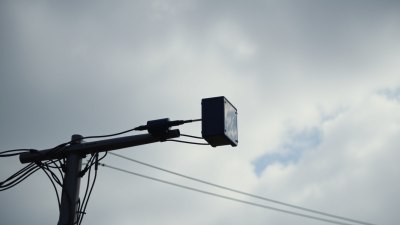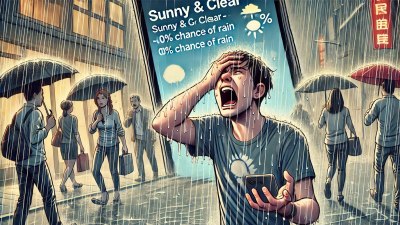Why You Instinctively Blame the Weather When Technology Fails
Explore why people often blame the weather for tech failures and the psychological and environmental reasons behind this instinctive reaction.

Image created with Flux Schnell
Technology has become an integral part of daily life, weaving itself into almost every aspect of modern existence. From smartphones and laptops to smart home devices and critical infrastructure systems, our reliance on technology is undeniable. However, when these devices fail, it is common for people to instinctively blame the weather. This reaction is not merely coincidence or superstition; rather, it emerges from a combination of psychological tendencies, historical associations, and environmental realities.
Understanding why the weather is often the first suspect in technological malfunctions requires exploring the connection between human cognition, environmental factors, and the visible impact the weather has on daily experiences. This article delves into the underlying reasons for this instinctive blame and offers insights into the complex relationship between weather and technology.
Historical Roots of Weather-Related Tech Failures
Before the digital revolution, early technologies such as telegraphs, railways, and electricity grids were highly susceptible to adverse weather conditions. Lightning, heavy rain, snowstorms, and wind have historically disrupted communication lines, power supplies, and transportation systems. For example, lightning strikes could easily fry telegraph wires, and snowstorms would halt trains, delaying the delivery of goods and messages.
These repeated disruptions created a cultural association between technology failures and the weather. Over generations, people came to expect that when something technological goes wrong, the weather is likely the culprit. This association is reinforced by tangible experiences from the past, making it a natural and familiar explanation.
Visibility and Perception of Weather
One reason people blame weather so readily is its omnipresence and visibility. When technology malfunctions, the problem is often invisible or difficult to understand - circuitry, software bugs, or network issues are hidden from plain sight. By contrast, weather is always visible and measurable: you can see the rain, feel the wind, or notice the storm clouds rolling in.
This visibility makes weather an easy scapegoat. The human brain prefers simple, visible explanations that it can quickly grasp. Since the weather is tangible and observable, it becomes the default cause when unseen technological forces malfunction.
Psychological Comfort and Predictability
Blaming the weather offers psychological comfort. Technology failures can be frustrating and anxiety-inducing, especially when they interrupt important tasks or cause safety concerns. When the cause is attributed to an external factor like weather, it reduces feelings of personal responsibility or helplessness related to complex systems beyond individual control.
Moreover, weather is cyclical and somewhat predictable. People understand that storms eventually pass and conditions improve. This predictability contrasts with the often opaque and unpredictable nature of technological glitches which can seem random and overwhelming. Thus, weather is perceived as a manageable cause, mitigating emotional stress.
Environmental Realities Affecting Technology
Although some attributions are psychological, the weather does play a significant role in real technology failures. Many devices and networks are vulnerable to environmental conditions due to their design and operational principles. For instance, extreme heat can cause overheating in computers, while moisture and humidity can lead to corrosion and short circuits in electronic components.
Surges in electrical demand during cold snaps or heatwaves can overload power grids, and heavy rain or flooding can damage underground cables and equipment. Lightning strikes remain a threat to electrical systems, and wind can physically damage antennas and satellite dishes. These realities reinforce the connection between weather and technology issues.
Examples of Weather-Related Technology Failures
Across the world, numerous examples illustrate the impact of weather on technology. In 2021, a severe winter storm in Texas caused widespread power outages as the demand surged and infrastructure failed. Similarly, hurricanes often disrupt communication networks by downing cell towers and flooding data centers. In urban areas, heatwaves increase the likelihood of internet slowdowns due to server overheating.
Even everyday consumer electronics are affected; exposure to moisture during rain can cause smartphones to malfunction, and solar panels experience reduced efficiency during cloudy or snowy conditions. These examples highlight the valid reasons behind weather being the default blame for disruptions.
The Role of Media and Social Narratives
Media reports often highlight weather-related causes during technological breakdowns, further embedding this association in public consciousness. Headlines mentioning storms, heatwaves, or cold snaps in conjunction with tech failures amplify the causal link and make it more memorable.
Social media also plays a role, as users frequently share experiences of technology going awry during adverse weather. This collective narrative reinforces common perceptions and norms about blaming weather, even in cases where the connection is tangential or coincidental.
Technological Advances and Mitigation Strategies
Modern engineering is increasingly designed to withstand environmental extremes. Weatherproof casings, surge protectors, temperature control systems, and redundant networks help mitigate weather’s impact on technology. For example, data centers employ advanced cooling systems and waterproof seals to protect equipment, while electrical grids incorporate lightning arresters and smart sensors to prevent failures.
Despite these advances, no technology is immune to extreme weather conditions, especially as climate change intensifies natural events. Hence, the tendency to blame the weather remains relevant and rational in many instances.
The Cognitive Bias Behind Weather Blame
Several cognitive biases contribute to the instinctive blaming of weather. The availability heuristic causes individuals to rely on immediate examples that come to mind, such as a recent storm coinciding with tech failure. Confirmation bias may lead people to remember weather-related outages more vividly, reinforcing their belief in causality.
Additionally, the fundamental attribution error nudges people to attribute failures to external factors like weather rather than internal technological faults or maintenance errors. These biases simplify complexity and make explanations more accessible.
When Weather Isn’t to Blame
It is important to recognize that technology fails for many reasons unrelated to the weather. Software bugs, hardware wear and tear, human error, cyberattacks, and manufacturing defects are common causes. In some cases, weather can be an innocent bystander, merely coinciding with a failure rather than causing it.
Applying critical thinking to assess failure causes beyond weather enables better troubleshooting and improved system resilience. However, the ease of blaming weather often overshadows this careful analysis.
Strategies for Users and Providers
Users can manage weather-related technology issues by protecting devices against moisture, avoiding exposure to extreme temperatures, and ensuring backup power sources during weather events. Providers can enhance infrastructure resilience by adopting robust engineering practices and comprehensive maintenance protocols.
Education about the real factors influencing technology reliability can help people temper instinctive weather blame and foster a more nuanced understanding of technological vulnerabilities.
Weather and Technology in a Changing Climate
Climate change is increasing the frequency and severity of extreme weather events - heatwaves, storms, floods—that threaten technological infrastructure. This evolving context makes the link between weather and technology even more salient, necessitating adaptive strategies in both design and operational policies.
As weather patterns become less predictable, technology systems must evolve to handle increased environmental stress, reinforcing why society remains vigilant about weather’s influence on technology performance.
In summary, instinctively blaming the weather when technology fails is rooted in historical experiences, psychological comfort, environmental realities, media influence, and cognitive biases. While weather often plays a valid role in technological issues, it is one of many contributing factors. Greater awareness of these dynamics can lead to improved technology resilience and a more balanced perspective on failure causes.











